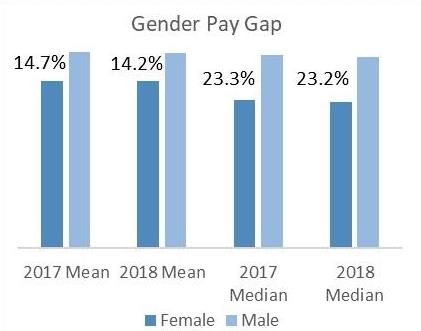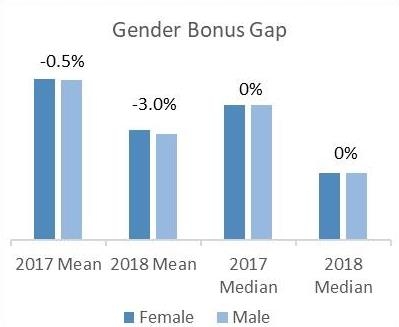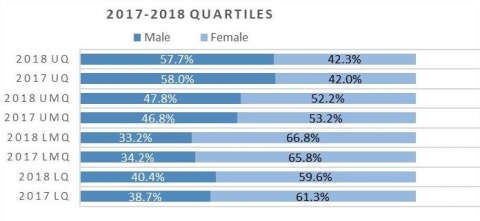Our gender pay gap figures
The gender pay gap shows the difference between the average (mean and median) earnings of men and women and is expressed as a percentage of men’s earnings.
A gender pay gap above zero will show that, on average, men earn more. Complying with statutory calculations, the University has identified its gender pay gap in relation to the:
- mean and median difference between hourly rates for males and females
- the mean and median difference between bonus pay for males and females
- the proportions of male and female employees who were paid bonus pay
- the proportions of male and female employees in each pay band quartile
Mean and median pay gap

The mean pay gap is the difference between the average hourly rate of pay between males and females. The University’s mean pay gap is 14.2% which is lower than the wider economy (17.4%*) and lower than the HE sector (15.5%*). This is a 0.5% reduction in the pay gap compared to the figure for 2017.
The median pay gap is the difference between the middle point of average hourly rates (when listed in numerical order) of pay for males compared to the middle point of average hourly rates of pay for females. The University’s median pay gap is 23.2% which is higher than the wider economy (18.4%*) and higher than the HE sector (14.3%*). This is largely due to the significantly higher proportion of female staff at the lower grades within the University’s pay structure. This represents a 0.1% reduction when compared with the previous year.
Gender bonus gap

Bonuses paid within the University are made via Recognition Awards paid to individuals and teams who have excelled in their performance.
The mean bonus gender pay gap shows the difference between the average bonus pay received by male and female staff. The University’s mean gender bonus gap is 0% no change from the previous year.
The median bonus gender pay gap for University staff is -3%, which was reported as -0.5% the previous year.
Proportion of male and female colleagues receiving a bonus
The proportion of colleagues across the University who received a bonus under the statutory definition was very close, with 67% of females receiving a bonus and 65.6% of males receiving a bonus.

Proportion of male and female colleagues in each pay quartile
The University has identified the percentage of female and male colleagues in each of four pay quartiles, by dividing the workforce into four equal parts.
Female colleagues account for 59.6% of the lowest quartile and 66.8% of the lower middle quartile.
The upper middle quartile is more balanced with female colleagues making up 52% of this population.
In the upper quartile, the split between female and male is 42% female and 58% male.

Why we have a gender pay gap
A major contributing factor to the University’s gender pay gap is the significantly higher proportion of females in the lower two pay quartiles, undertaking roles such as administration and catering which traditionally have attracted female applicants. These roles have also tended to provide flexibility around part time working, which is attractive to those with caring responsibilities, historically impacting on women more than men.
Another contributing factor to the University’s pay gap is the higher proportion of males in more senior academic roles, with only 29% of professors being female. This is not only a concern for the University but a wider known issue across the Higher Education sector.
We need to increase the numbers of women in leadership positions across the University, particularly in academic roles, and we also need to ensure that roles at all levels across the University attract a diverse pool of applicants.
The University recognises that many challenges remain and is determined to take action to ensure that our day-to-day practice reflects the quality of our policy commitments.
How we're addressing the gender pay gap
Equality and inclusion is integral to the University’s People Strategy and the University is committed to deliver against its ambitions as outlined in this Strategy.
Athena SWAN action plan
The University is very proud to have achieved a Bronze Award for the Equality Challenge Unit (ECU) Athena SWAN Charter, in recognition for work undertaken to address gender equality across the University.
The University is committed to achieving a Silver Award in 2021 and has developed a comprehensive action plan in order to achieve this.
An important element of the Athena SWAN Action Plan is to ensure our recruitment policies and processes support the achievement of gender equality.
Examples of actions delivered include unconscious bias training rolled out across the University, criteria around salary on appointment reviewed and monitored, and ensuring that interview panels are gender balanced wherever possible.
Performance and Development Review (PDR)
A revised on-line Performance and Development Review (PDR) scheme, linked to a new Career Development Framework is being introduced from 1 April 2019. The Career Development Framework underpinning the PDR scheme helps staff to identify and build on strengths, explore opportunities within the University and identify how to access resources.
Aurora and Springboard programmes
We have an ongoing commitment to Aurora and Springboard programmes which support women’s career development and promotion prospects. The Aurora Programme is run by the Leadership Foundation for Higher Education. This programme is run by women for women and draws on successful women from higher education and other sectors as speakers and role models to share their experiences and knowledge about the world of work and career development. The Springboard Programme is a three month personal and work development programme for women, not a management development programme, but designed to complement the Aurora Programme and help prepare women, where appropriate, to apply for future Aurora Programmes. To date 204 staff have completed the Springboard programme and 84 staff have completed the Aurora Programme.
Monitoring success
In order to monitor the success of these initiatives in reducing the University’s Gender Pay Gap, ongoing reporting and analysis will be undertaken and embedded into the University’s wider workforce reporting.
